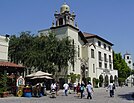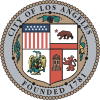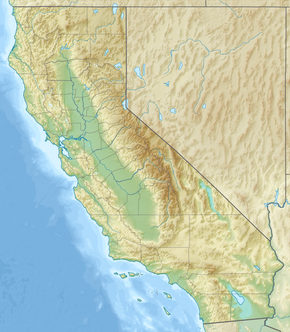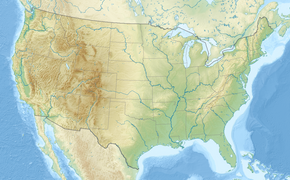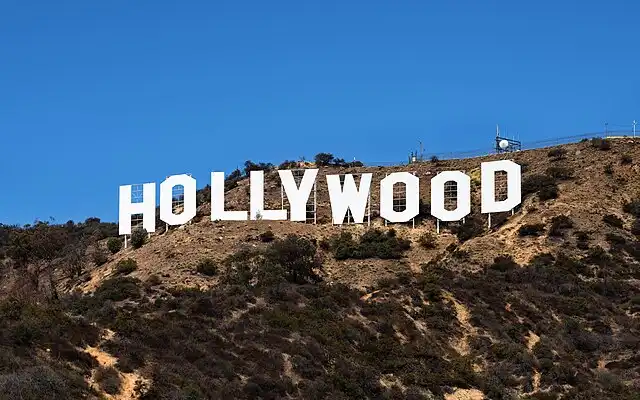
Los Angeles
Largest city in California, United States / From Wikipedia, the free encyclopedia
Dear Wikiwand AI, let's keep it short by simply answering these key questions:
Can you list the top facts and stats about Los Angeles?
Summarize this article for a 10 year old
Los Angeles,[lower-alpha 1] often referred to by its initials L.A., is the most populous city in the U.S. state of California. With roughly 3.9 million residents within the city limits as of 2020[update],[7] Los Angeles is the second-most populous city in the United States, behind only New York City; it is also the commercial, financial and cultural center of Southern California. Los Angeles has a Mediterranean climate, an ethnically and culturally diverse population, and is the principal city of a metropolitan area of 13.2 million people. Greater Los Angeles, which includes the Los Angeles and Riverside–San Bernardino metropolitan areas, is a sprawling metropolis of over 18 million residents.
Los Angeles | |
|---|---|
| Nicknames: | |
 Location within Los Angeles County | |
| Coordinates: 34°03′N 118°15′W | |
| Country | United States |
| State | California |
| County | Los Angeles |
| Region | Southern California |
| CSA | Los Angeles-Long Beach |
| MSA | Los Angeles-Long Beach-Anaheim |
| Pueblo | September 4, 1781[2] |
| City status | May 23, 1835[3] |
| Incorporated | April 4, 1850[4] |
| Named for | Our Lady, Queen of the Angels |
| Government | |
| • Type | Strong mayor–council[5] |
| • Body | Los Angeles City Council |
| • Mayor | Karen Bass (D) |
| • City Attorney | Hydee Feldstein Soto (D) |
| • City Controller | Kenneth Mejia (D) |
| Area | |
| • Total | 501.55 sq mi (1,299.01 km2) |
| • Land | 469.49 sq mi (1,215.97 km2) |
| • Water | 32.06 sq mi (83.04 km2) |
| Elevation | 305 ft (93 m) |
| Highest elevation | 5,075 ft (1,576 m) |
| Lowest elevation | 0 ft (0 m) |
| Population | |
| • Total | 3,898,747 |
| • Estimate (2022)[7] | 3,819,538 |
| • Rank | 3rd in North America 2nd in the United States 1st in California |
| • Density | 8,304.22/sq mi (3,206.29/km2) |
| • Urban | 12,237,376 (US: 2nd) |
| • Urban density | 7,476.3/sq mi (2,886.6/km2) |
| • Metro | 13,200,998 (US: 2nd) |
| Demonyms | Angeleno, Angelino, Angeleño[10][11] |
| GDP | |
| • MSA | $1.227 trillion (2022) |
| • CSA | $1.528 trillion (2022) |
| Time zone | UTC–08:00 (PST) |
| • Summer (DST) | UTC–07:00 (PDT) |
| ZIP Codes | List
|
| Area codes | 213, 323, 310, 424, 818, 747, 626 |
| FIPS code | 06-44000 |
| GNIS feature IDs | 1662328, 2410877 |
| Website | lacity |
The majority of the city proper lies in a basin in Southern California adjacent to the Pacific Ocean in the west and extending partly through the Santa Monica Mountains and north into the San Fernando Valley, with the city bordering the San Gabriel Valley to its east. It covers about 469 square miles (1,210 km2),[6] and is the county seat of Los Angeles County, which is the most populous county in the United States with an estimated 9.86 million residents as of 2022[update].[16] It is the fourth-most visited city in the U.S. with over 2.7 million visitors as of 2022.[17]
The area that became Los Angeles was originally inhabited by the indigenous Tongva people and later claimed by Juan Rodríguez Cabrillo for Spain in 1542. The city was founded on September 4, 1781, under Spanish governor Felipe de Neve, on the village of Yaanga.[18] It became a part of Mexico in 1821 following the Mexican War of Independence. In 1848, at the end of the Mexican–American War, Los Angeles and the rest of California were purchased as part of the Treaty of Guadalupe Hidalgo and became part of the United States. Los Angeles was incorporated as a municipality on April 4, 1850, five months before California achieved statehood. The discovery of oil in the 1890s brought rapid growth to the city.[19] The city was further expanded with the completion of the Los Angeles Aqueduct in 1913, which delivers water from Eastern California.
Los Angeles has a diverse economy with a broad range of industries. Los Angeles is best known as the home of the Hollywood film industry, the world's largest by revenue; the city was an important site in the history of film. It also has one of the busiest container ports in the Americas.[20][21][22] In 2018, the Los Angeles metropolitan area had a gross metropolitan product of over $1.0 trillion,[23] making it the city with the third-largest GDP in the world, after New York and Tokyo. Los Angeles hosted the Summer Olympics in 1932 and 1984, and will also host in 2028. Despite a business exodus from Downtown Los Angeles since the COVID-19 pandemic, the city's urban core is evolving as a cultural center with the world's largest showcase of architecture designed by Frank Gehry.[24] More recently, statewide droughts in California have strained both the city's and Los Angeles County's water security.[25][26]



